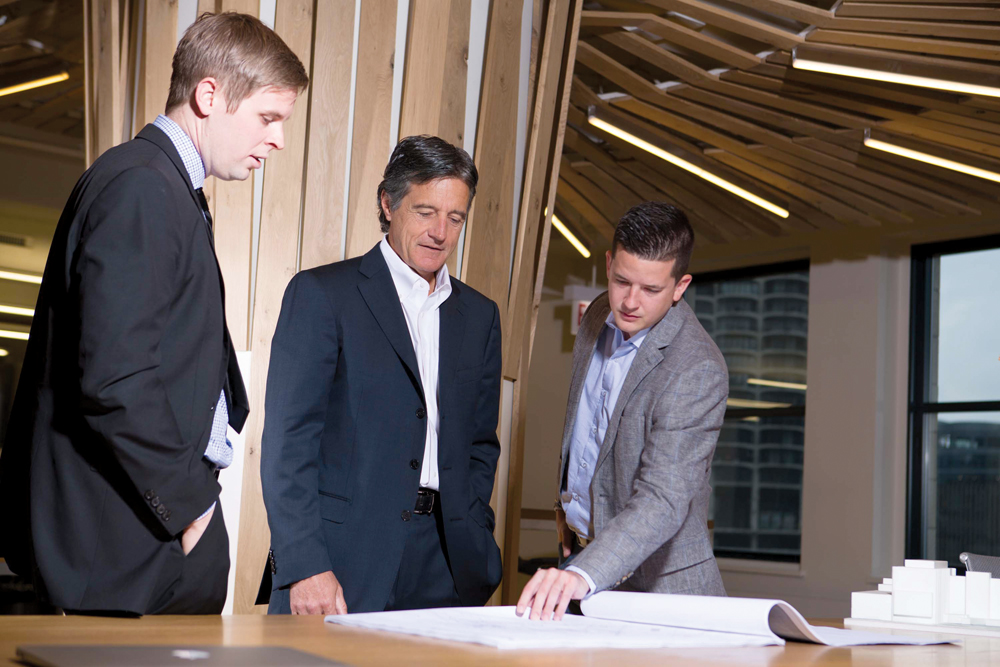Design-build firm Clayco has launched an investment arm called Treehouse Adventures to provide financing and operational infrastructure to startups, including those serving the AEC industry.
“We see a lot of opportunities in construction services,” says Michael Latiner, who joined Clayco last November as Treehouse’s President and Principal.
The goal is to create an environment where fledgling companies can concentrate on innovation and worry less about running a business. Clayco has dedicated the 14th floor of its headquarters in Chicago to provide space for the startups.
Treehouse’s first investment is Chicago-based Ventana Design-Build Systems, a five-month-old company that designs, supplies, and installs high-performance glass curtain wall façade systems. Latiner says Ventana’s President, Bob Trainor (center in photo, flanked by VPs Marty Trainor, left, and Ryan Murphy), was known in the business and had the ideas and processes, but needed Clayco’s operational backbone for support. “We were able to get them up and running in a week,” says Latiner.
Trainor says that Treehouse uses Clayco’s back-office services to provide marketing, IT, legal, and accounting support. It also provides an experienced senior management team and a network of relationships that startups like Ventana can leverage.
Treehouse doesn’t have a dedicated fund set aside for investment, but Latiner says he anticipates investing in two or three companies a year. A second deal has already been cut, with a technology startup whose expertise is making buildings smarter.
Read about more innovations from BD+C's 2014 Great Solutions Report.
Related Stories
| Nov 27, 2013
Wonder walls: 13 choices for the building envelope
BD+C editors present a roundup of the latest technologies and applications in exterior wall systems, from a tapered metal wall installation in Oklahoma to a textured precast concrete solution in North Carolina.
| Nov 27, 2013
University reconstruction projects: The 5 keys to success
This AIA CES Discovery course discusses the environmental, economic, and market pressures affecting facility planning for universities and colleges, and outlines current approaches to renovations for critical academic spaces.
| Nov 26, 2013
7 ways to make your firm more successful
Like all professional services businesses, AEC firms are challenged to effectively manage people. And even though people can be rather unpredictable, a firm’s success doesn’t have to be. Here are seven ways to make your firm more successful in the face of market variability and uncertainty.
| Nov 26, 2013
Design-build downsized: Applying the design-build method in an era of smaller projects
Any project can benefit from the collaborative spirit and cooperative relationships embodied by design-build. But is there a point of diminishing return where the design-build project delivery model just doesn't make sense for small projects? Design-build expert Lisa Cooley debates the issue.
| Nov 25, 2013
Electronic plan review: Coming soon to a city near you?
With all the effort AEC professionals put into leveraging technology to communicate digitally on projects, it is a shame that there is often one major road block that becomes the paper in their otherwise “paperless” project: the local city planning and permitting department.
| Nov 22, 2013
Kieran Timberlake, PE International develop BIM tool for green building life cycle assessment
Kieran Timberlake and PE International have developed Tally, an analysis tool to help BIM users keep better score of their projects’ complete environmental footprints.
| Nov 20, 2013
Architecture Billings Index slows in October; project inquiries stay strong
Following three months of accelerating demand for design services, the Architecture Billings Index reflected a somewhat slower pace of growth in October. The October ABI score was 51.6, down from a mark of 54.3 in September.
| Nov 19, 2013
Pediatric design in an adult hospital setting
Freestanding pediatric facilities have operational and physical characteristics that differ from those of adult facilities.
| Nov 18, 2013
6 checkpoints when designing a pediatric healthcare unit
As more time and money is devoted to neonatal and pediatric research, evidence-based design is playing an increasingly crucial role in the development of healthcare facilities for children. Here are six important factors AEC firms should consider when designing pediatric healthcare facilities.
| Nov 18, 2013
Lord Aeck Sargent opens metro D.C. office, updates brand
Architecture, design, and planning firm unveils its sixth office, plus a new visual identity system and website
















